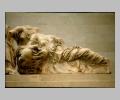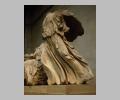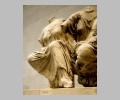
East Pediment: Figures L ('Dione') and M ('Aphrodite')

East Pediment: Figures K ('Hestia'), L ('Dione') and ...

East Pediment: Figures F ('Demeter') and G ('Artemis')

East Pediment: Figures K ('Hestia') and L ('Dione')

East Pediment: Figures D, E, F and G ('Dionysos', 'Kore&ap...
| Collection: | London, British Museum and Athens, Acropolis Museum |
| Title: | Parthenon, East Pediment |
| Context: | From Athens, Acropolis |
| Findspot: | Found at Athens, Acropolis |
| Summary: | Birth of Athena |
| Sculptor: | Literary attestation to Pheidias |
| Material: | Marble |
| Sculpture Type: | Architectural |
| Category: | Statuary group |
| Placement: | East pediment |
| Style: | High Classical |
| Technique: | In-the-round |
| Original or Copy: | Original |
| Date: | 447 BC - 432 BC |
| Dimensions: | H. of Figure D 1.21 m, H. of Figure G 1.73 m, H. of Figure K 1.30 m, Overall L. of group KLM 3.15 m |
| Scale: | Over life-size |
| Region: | Attica |
| Period: | High Classical |
Subject Description: Birth of Athena (East Pediment): The setting is apparently Olympus with Helios (figures A-C) and Selene-Nyx (N-O) in the corners providing a temporal element. Central scene comprises Athena, fully grown and armed, standing before her father Zeus (enthroned), Hephaistos who springs back upon witnessing the miraculous birth in which he assisted, and probably Hera. This scene is flanked by many other figures who are all probably Olympian deities present at the birth, possibly including two chariot groups (though this is controversial). Figure D, a nude male reclining on an animal skin, is most commonly identified as Dionysos, though suggested alternatives are Herakles, Ares and Theseus. E and F, both wearing peploi, are usually identified as Demeter and Kore because of the boxes on which they are seated which some would see as Eleusinian cistae. The running peplophoros G is variously identified as Artemis or Eileithyia. Torso H could be Poseidon or Hephaistos. Of the famous group of KLM (which used to be called the Three Fates), K, who is seated on what may be a household altar, is now identified as either Hestia (patron of the hearth) or Leto, L now Dione (mother of Aphrodite), Themis or Artemis, and reclining M is agreed to represent Aphrodite. K, L and M all wear chitons and have himatia across their legs.
Form & Style: Figure D has been called the reclining Doryphoros because of his powerful musculature, heavy proportions and the chiastic contrapposto position of his limbs, all considered to be Polykleitan characteristics. Figures E and F are soberly clad in heavy material that falls in deep folds. The strong indentation below the ribs of torso H links this in style with Figure H from the West pediment. The drapery of Figures K, L and M is diaphanous and clinging, revealing in particular the voluptuous form of M beneath.
Condition: Fragmentary
Condition Description: Parts of limbs of all figures are missing. Figure D is the only sculpture from the Parthenon pediments with its head intact. Most surfaces chipped and abraded.
Material Description: Pentelic Marble
Associated Building: Athens, Parthenon
Sources Used:
